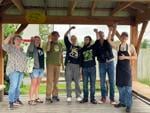Cafe Chicago has hit the ground, running, stumbling, and flying. All at the same time.
First, the ground. We are creating a reality where the immigrant day laborers who are involved in Cafe Chicago can one day take it on fully, themselves, with the proper training. Personally, I did not know how much work this would be, but we are all committed to the idea, and the transfer is taking huge amounts of energy and time. That said, our cooperative members are taking on responsibilities as they can, and though it would have been easier to start a fair trade organic coffee company that funds social change and run by experienced outsiders, we really are maintaining a vision that we believe will prove to be where the deeper transformation happens, economic, social, and really, spiritual. Putting the workers in the drivers' seat.
We've had events at the Workers Center where 75 people showed up from all round Chicago, eager to learn about our work, wanting to take the ideas back to their communities, listening and singing along with the singer songwriters we've brought in to document our work in musical form. And it is here that we now realize, we've sparked a bona fide grassroots movement. From below. Pretty intense.
The cooperative has four regular members, and a dozen other day laborers involved in various ways, less regularly.
We've gotten huge name recognition in Chicago, while selling maybe 80-100 lbs of coffee per week (tiny!). We are working out so many glitches that come up with our language barriers, people's previous lack of experience of taking responsibility and ownership, lack of experience with business ....
But we seem to hit on the right methods slowly, and are good at bringing in outside support (for example, our college professor friend who is working on our Business Plan with us, has provided an amazing clarifying and focusing of our mission and our business). So, hitting the ground's proven to have quite a few stumbles, but we are learning to walk.
It helps to have a damn good rich and chocolatey coffee, from La FEM in the highlands of Nicaragua. At La FEM, the women who participate in the cooperative not only grow these magical beans but teach and learn construction and other building skills essential to further survival and thriving.
Our name recognition is coming through word of mouth; and a lot of writing skills put to good use in social media; the sway of the Latino Union and of the Chicago Coffee Confederation in different and complementary arenas; it's a real nice mish mash.
We have very good networks with almost all segments of Chicago's arts, radical, immigrant, worker, and progressive communities and our organizations. Our media work has exceeded all expectations, and is where we are flying: an article in internationally-read Latin American Herald Tribune;
ChicagoUnionNews.com did a piece that put us in front of Chicago's unions (and national ones as well); and a piece on ABC7 News during primetime, probably the biggest visual media in Chicago, where we performed quite quite well. The New York Times will be around soon, it's the first media avenue I've begun to actively pursue.
All that said, we are now aware that we are not only a part of a large-scale economic seachange, but a leading voice. A tugboat. And we are keeping in mind, because we've sparked so many imaginations and tapped into a model of grasping and taking the reins of self-determination, that we can assist others in creating similar endeavors. Whether in coffee or other essentials. We hope to work with some of the other organizations in the National Day Labor Organizing Network, to establish ten more Cafe ______'s in different cities, by the end of 2013. They've been calling us, watching us, supporting us.
Locally, we've identified other niches where projects like worker-owned Cafe Chicago would have wide open space for success (such as a fair trade organic tortilleria), and rather than thinking we can do this too, will start working with others so that they can begin the process. Expanding horizontally, as the Chicago Coffee Confederation has, rather than vertically.
There's a lot more that could be said, but I wanted to let you know where we're at, and again thank you for your support, that support has proven to be vital to our sense that yes, we can do this, and others think so too.
So Thanks! And happy holidays to you ...
David





